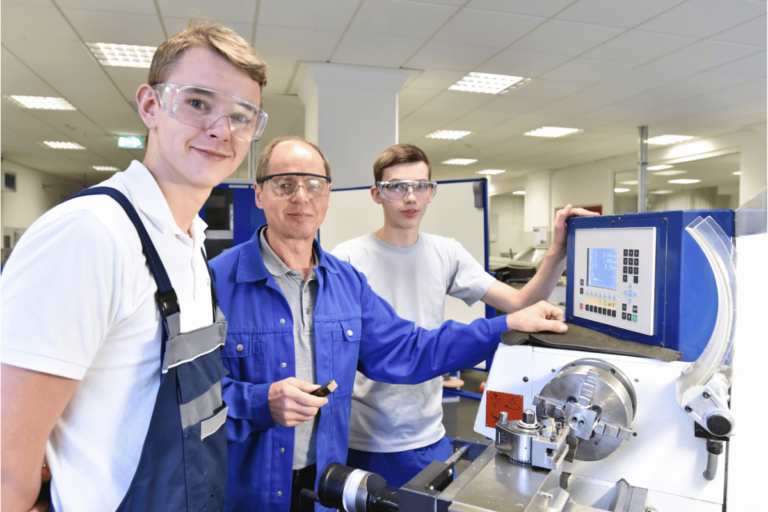Did you know that over 50% of vocational skill development can be enhanced through the use of augmented reality (AR)?
With AR technology, you can now immerse yourself in a hands-on learning experience, receiving personalized instruction and real-time feedback.
This innovative approach revolutionizes vocational training by overcoming traditional challenges and providing a more effective way to develop essential skills.
In this article, we will explore the benefits and applications of utilizing AR to improve vocational skill development.
Key Takeaways
- Over 50% of vocational skill development can be enhanced through the use of augmented reality (AR).
- AR provides a highly immersive and interactive learning experience.
- AR improves retention by actively engaging learners with virtual objects and simulations.
- AR allows for personalized instruction and real-time feedback, accelerating the learning process.
The Benefits of Augmented Reality in Vocational Skill Development
How can augmented reality (AR) enhance your vocational skill development?
Augmented reality offers numerous benefits when it comes to improving retention and increasing engagement in vocational skill development. By integrating virtual elements into the real world, AR provides a highly immersive and interactive learning experience.
One key advantage of AR is its ability to improve retention. Traditional learning methods often rely on textbooks or lectures, which can be passive and less memorable. However, with AR, learners can actively engage with virtual objects, scenarios, and simulations, making the learning process more dynamic and memorable. This active engagement helps learners retain information better and enhances their overall understanding of the subject matter.
In addition to improving retention, AR also increases engagement in vocational skill development. The interactive nature of AR applications allows learners to actively participate in real-world scenarios, enhancing their motivation and interest. By incorporating gamification elements and challenges, AR keeps learners engaged and motivated to achieve their vocational goals.
Furthermore, AR can simulate real-world environments, providing learners with hands-on experience without the need for expensive equipment or physical resources. This not only increases engagement but also allows learners to practice and refine their skills in a safe and controlled environment.
Enhancing Hands-On Learning With Augmented Reality
You can enhance your hands-on learning experience by incorporating augmented reality (AR) into your vocational skill development. AR technology allows for immersive experiences and interactive simulations, which can greatly enhance your understanding and retention of vocational skills.
By integrating AR into hands-on learning, you can benefit from a more engaging and dynamic educational experience. AR overlays digital content onto the real world, creating a blended environment where you can interact with virtual objects and receive real-time feedback. This technology enables you to practice and refine your skills in a safe and controlled environment, without the need for expensive equipment or physical resources.
To give you a better idea of how AR can enhance hands-on learning, consider the following table:
| Traditional Hands-On Learning | Hands-On Learning with AR |
|---|---|
| Limited access to resources | Access to unlimited virtual resources |
| Fixed learning environment | Dynamic and customizable learning environment |
| Limited opportunities for practice and feedback | Continuous practice and real-time feedback |
As you can see, incorporating AR into hands-on learning can provide you with a more immersive and interactive learning experience. It allows you to access a wide range of virtual resources, customize your learning environment, and receive continuous practice and feedback. These advantages can significantly enhance your vocational skill development and help you become a more proficient and confident professional.
Personalized Instruction and Real-Time Feedback With AR
With AR, you can receive personalized instruction and real-time feedback to enhance your vocational skill development. Augmented Reality (AR) technology has revolutionized the way we learn and acquire new skills. By incorporating AR into vocational training, learners can benefit from customized instruction tailored to their specific needs and real-time feedback that enables them to improve their skill retention and increase engagement.
One of the key advantages of personalized instruction with AR is that it allows learners to learn at their own pace and in their preferred learning style. AR applications can adapt to individual skill levels and provide targeted instruction, ensuring that learners receive the support they need to succeed. This personalized approach not only improves skill retention but also enhances learner engagement by making the learning experience more relevant and meaningful.
Real-time feedback is another valuable feature of AR in vocational skill development. With AR, learners can receive immediate feedback on their performance, allowing them to identify areas for improvement and make necessary adjustments in real-time. This instant feedback loop not only accelerates the learning process but also boosts learner motivation and confidence.
Augmented Reality Applications for Vocational Training
Explore the various applications of augmented reality (AR) for vocational training to enhance your skill development.
Augmented reality has proven to be a valuable tool in various industries, including healthcare training and the construction industry.
Here are three key applications of augmented reality in vocational training:
-
Augmented reality in healthcare training: AR technology can be used to simulate realistic medical scenarios, allowing healthcare professionals to practice their skills in a safe and controlled environment. For example, medical students can use AR to perform virtual surgeries, allowing them to gain hands-on experience before operating on real patients. This immersive training can improve their surgical techniques and decision-making abilities.
-
Augmented reality in the construction industry: AR can be utilized to train construction workers in various tasks such as equipment operation, safety protocols, and building maintenance. By overlaying virtual information onto the physical environment, workers can visualize complex construction plans, identify potential hazards, and learn how to operate machinery effectively. This technology reduces the risk of accidents and improves overall productivity on construction sites.
-
Augmented reality for skill assessment: AR can also be used to assess vocational skills. By tracking the user’s movements and interactions in real-time, AR can provide immediate feedback and performance evaluations. This allows trainees to identify areas for improvement and adjust their techniques accordingly. Such assessments can be particularly useful in industries where precision and accuracy are vital, such as manufacturing or aviation.
Overcoming Challenges and Implementing AR for Skill Development
One of the key challenges in implementing augmented reality (AR) for skill development is ensuring compatibility with existing training programs and infrastructure. AR technology requires specific hardware and software that may not be readily available or compatible with the current systems in place. Companies and organizations will need to invest in the necessary equipment and ensure that their existing infrastructure can support AR implementation. Additionally, there may be resistance to change from employees and trainers who are accustomed to traditional training methods. Overcoming these challenges requires careful planning and communication to address concerns and provide training and support for those who may be less familiar with AR technology.
To successfully implement AR for skill development, organizations must also consider the cost and time required for development and implementation. Creating AR content and applications can be a complex and time-consuming process, requiring skilled developers and designers. Additionally, the cost of hardware and software, as well as ongoing maintenance and updates, must be taken into account.
The table below summarizes some of the key challenges and considerations in implementing AR for skill development:
| Challenges | Implementation Considerations |
|---|---|
| Compatibility | Ensure compatibility with existing training programs and infrastructure. |
| Resistance to change | Address concerns and provide training and support for employees and trainers. |
| Cost and time | Consider the cost and time required for development and implementation. |
| Skilled developers | Allocate resources for skilled developers and designers. |
| Maintenance and updates | Plan for ongoing maintenance and updates of hardware and software. |
Conclusion
In the realm of vocational skill development, augmented reality (AR) emerges as a transformative tool. By enhancing hands-on learning, providing personalized instruction, and offering real-time feedback, AR revolutionizes the way individuals acquire and refine their skills.
Its applications in vocational training have the potential to bridge gaps and overcome challenges. As we embrace the power of AR, we open doors to a future where skill development is immersive, interactive, and tailored to individual needs, leading to a more competent and confident workforce.

